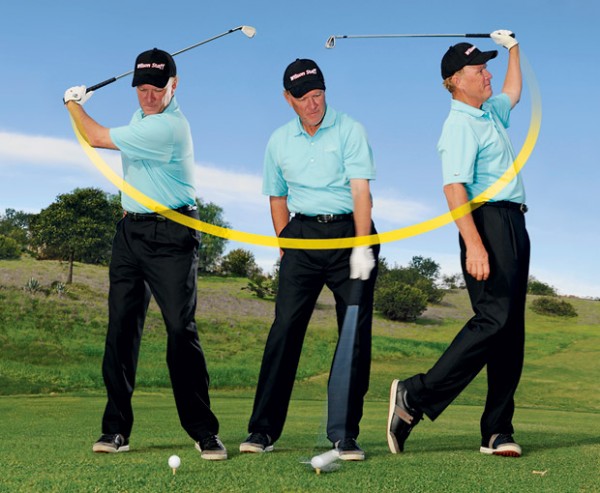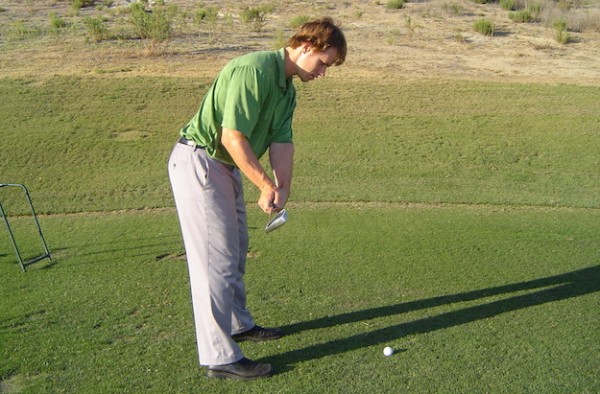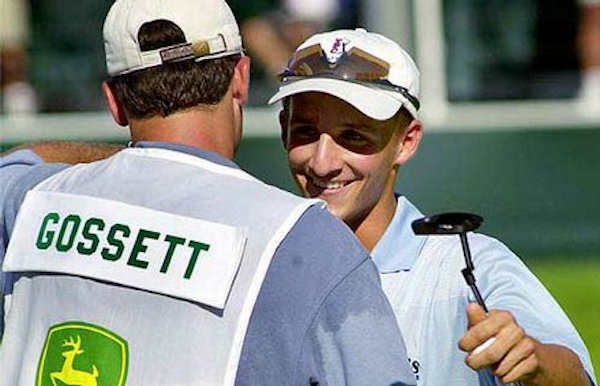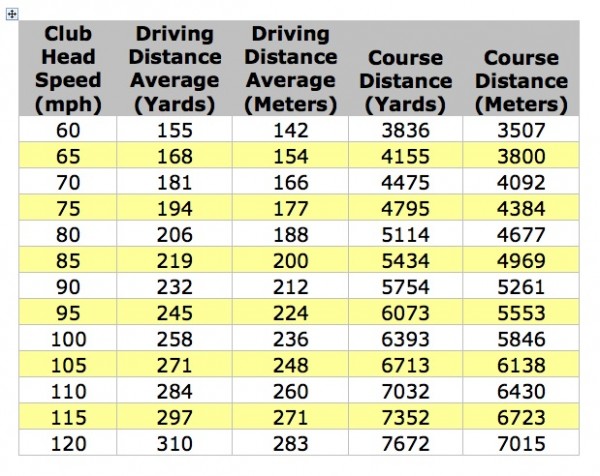Instruction
Get better faster: The 80-20 of golf improvement

Recently I got the following email from one of our Swing Man Golf members named Ken.
Hi Jaacob, Since you’ve been able to do what I’m trying to do, I’m hoping to get some insight from you. I have one question for you, so it should be brief. I’m a big proponent of the 80-20 principle; what do you think gave you the most bang for your buck in terms of improving your score?
According to Wiki, the 80-20 principle, also known as the Pareto principle, states that 80 percent of the effects come from 20 percent of the causes. Business-management consultant Joseph Juran suggested the principle and named it after Italian economist Vilfredo Pareto, who observed in 1906 that 80 percent of the land in Italy was owned by 20 percent of the population. Pareto developed the principle by observing that 20 percent of the pea pods in his garden contained 80 percent of the peas. Wiki also states that it is a common rule of thumb in business that 80 percent of a business’ sales come from 20 percent of its clients”.
I replied to Ken’s message with a few things off the top of my head, but his question got me thinking that a more thorough answer would make for a great article. Personally, I have a very busy life, as I’m sure is the case with many of you. So to get the most bang for your buck, here’s what I’d recommend for you to drop the most amount of shots with the least amount of work.
1. Watch the Clubface Rotation
First, cut down on the amount of clubface rotation in your full swing, pitches and chips. I’ve written about this in previous articles, but I’ll briefly go over it again because it made such a big difference in helping me shoot lower scores.
It used to be that I would start my swing by opening up the clubface relative to my swing path, such that when the shaft was parallel to the ground in the beginning of the back swing, the toe of the club pointed up to the sky in to a position that strangely is sometimes called square. On the way back down, I would roll the club over to impact and pass through to an opposite position on the other side in which toe was pointed back up to the sky when the shaft was again parallel to the ground.
I instinctively wanted to keep the club face more square to my swing path down through the hitting zone, but I figured since so many top players and teachers played with and advocated this rolling-type of hand action that it must be the best way. As soon as my first golf coach, Dan Shauger, took out this excessive rolling action in my swing and gave me the confirmation that it was okay to do so, I immediately started getting more control of my ball and my shot dispersion tightened up tremendously. Over the years, this change also saved me a lot of time on the range. I have been able to maintain an elite level of play with much less practice because my swing became less dependent on timing.
So that’s the first thing I’d say. If you’re having trouble controlling your ball, watch your club face rotation. It’s made a difference to the scores of many of the students I’ve had implement it, and it could do the same for you.
2. Swing Under Control
Second, discipline yourself to always swing under control. I’m talking about full swings here, but this actually applies to all shots. For example, on the pitches, chips, and putts, be smooth and watch being too jerky.
Especially for us guys with our egos, swinging under control is easier said than done. It certainly was one of the more difficult things I had to overcome. However, it is an important lesson because swinging under control can mean better balance, more consistent contact, faster club head speeds, etc.
Further more, shooting lower scores isn’t necessarily about hitting perfect shots. Rather, it’s about cutting down your average dispersion and making your overall misses better in order to eliminate disasters. There are things that point to swinging under control all over the golf world. Count Yogi talked about being boneless. Mike Austin talked about supple quickness and not impeding the pendulum. George Knudson said never to swing beyond a point that takes you out of balance. I like to think of it as watching the amount of tension in your swing. They’re all more-or-less different signposts that point in the direction of the same important lesson.
If you like numbers, earlier this summer PGA Tour winner David Gossett and I were hitting balls and talking about his swing speed using a Sports Sensors Swing Speed Radar. I had him make driver swings at a speed at which he felt like he could hit straight and keep under control. Then I had him swing as fast as he could. The difference was about 8 percent, meaning that he can control his ball at up to 92 percent of his maximum speed. Similarly, I’ve done this test on myself and I am also about 92 percent.
You may be a little more or less than David or myself, but you can do a similar test on yourself to learn your maximum threshold. If you don’t have a radar handy, you can test yourself on the range to learn the feeling at which point your precision starts taking a big dive. Then it’s just a matter of paying attention on the course and training yourself to never go above your personal threshold.
Be prepared for a back and forth tennis match with yourself to create this habit, but your scores will thank you for learning the lesson.
3. Get Custom Fit
Third, you certainly can play good golf with poorly fit golf clubs, but it is much easier to do so if you’ve been custom fit.
I’ll liken this to going out and running a 100-meter race on the track. If you throw on some big red floppy clown shoes, you probably won’t run as fast as if you had a nice pair of correctly-sized track shoes. Likewise, you can perform much better when you get custom fit for your golf equipment. It may cost a little bit more money in the short term, but it saves you in the long run. I won’t get into details in this article, but a knowledgeable teaching pro or club fitter can help you put together a set of clubs that works for you and your style of play on the types of courses you most regularly encounter.
For example, they can help you find a driver that optimizes your launch conditions for maximum carry and roll (although this isn’t always desirable), determine what and how many clubs you’d need to achieve sufficient distance gapping (sometimes you may not need a full set of 14 clubs), figure out how much bounce you need on wedges to be more effective around the greens and determine the amount of loft you need on your putter to get the ball rolling immediately, etc. All of these things can make scoring lower much easier. If possible, get fit at a facility that uses Doppler radar launch monitors like FlightScope or Trackman.
For more information about getting custom fit, you might also read some of the GolfWRX articles by my friend Tom Wishon.
4. Be Consistent
Fourth, to play good golf, it’s important to be consistent. As the saying goes, it’s difficult to master something you are constantly changing. Ironically, to go somewhere you’ve never been, you may need to do things differently than you’ve done before.
This is where a good coach can come in handy. Depending on your goals and how much time you have available, it may or may not be a good idea for you to make certain changes to your technique, equipment, swing thoughts, etc. Something may be more optimal from a scientific standpoint, but that doesn’t mean it’s going to be more functional for you.

I once had a 1-hour lesson with Dean Reinmuth, the swing coach of Ricky Barnes, and he noticed a couple subtleties in my game that helped right away.
There’s a Tour player I know whose name I won’t mention. He took up the game rather late compared to most pros, but he pretty quickly self-taught himself to shoot in the mid-60s and he even set a number of course records. Then in order to become more competitive, he decided he need to get a swing coach so he could swing more properly. The coach was well meaning, but they made some changes that completely wrecked my buddy’s natural move to the point where he now struggles to make cuts. I fear he may not survive as a Tour pro.
Interestingly, the guy who has the best chipping game I’ve ever seen in person out of both amateurs and pros is a former scratch-level college player who has been using the same exact wedge and unconventional technique for over 30 years. Therefore, make changes as you and, if you have them, your coach or team feels necessary. However, do so with a great deal of caution because you may be better off perfecting existing parts of your game through some goal setting, well-balanced practice, consistent repetition and mental game work versus changing to something different in regards to your technique, equipment, swing thoughts, etc.
5. Increase Your Club Head Speed
Finally, make sure you have enough club head speed to play your desired tee boxes. An average Tour-level course rates around 74.7 and is roughly 7,224 yards long. To play these type of courses, golfers could probably get away with a driver swing speed of about 100 mph at shorter venues with more generous openings to the greens. But they would also need to be crazy good with their hybrids and long irons, as well as have a superhuman short game. A more realistic swing speed goal is 104-to-105 mph. If you want to play like the average Tour player, you would need to have a swing speed of about 113 mph.
I’ve experimented playing in various professional events as both a power player and a shorter, more accurate hitter, shooting tournament rounds in the 60s both ways. On the shorter courses with soft greens or not as much forced carry, I was fine either way. However, I really struggled with the shorter more accurate style of play as soon as I got to a long sea-level course with hard greens. I couldn’t reach as many par 5’s in two, and coming in with so many hybrids and long irons to par-4’s made it difficult to get the ball landing steeply enough and with sufficient spin to stop the ball anywhere close to the hole.
Having enough club head speed really makes scoring a lot easier. To give you some guidance, take a look at the chart I’ve made below and find how fast you swing your driver (or how far you hit your driver if you don’t know your club head speed). From there, you’ll see the approximate course distance you should play to similarly experience what the average Tour player experiences when playing a Tour level course at 113 mph.
If you find that you are biting off more than you can chew, then to boost your scores I’d either recommend moving up to a more appropriate tee box for your existing level of power (even if that means going up to the forward tee box), or doing 10-to-15 minutes of swing speed training twice per week like what is outlined at Swing Man Golf in order to get your club head speed up to a level where you can manage better scores at the course distances you want to play. The idea with swing speed training is to train to increase your maximum club head speed so that when you back off to 92 percent of your max (or whatever your personal precision threshold happens to be), your “playing speed” also goes up proportionally. You could have the greatest technique in the world, but if your body isn’t conditioned to execute your technique with sufficient speed for the tee boxes you want to play, you’ll just be trying to scale a scoring mountain that is more-or-less insurmountable.
So there’s the 80-20 answer for me as far as it went with lowering my golf scores in big chunks. Give these things a try and hopefully you’ll find similar benefit for your own games. Have fun and good luck!
- LIKE140
- LEGIT15
- WOW9
- LOL4
- IDHT2
- FLOP4
- OB4
- SHANK17
Instruction
Clement: Laid-off or perfect fade? Across-the-line or perfect draw?

Some call the image on the left laid off, but if you are hitting a fade, this could be a perfect backswing for it! Same for across the line for a draw! Stop racking your brain with perceived mistakes and simply match backswing to shot shape!
- LIKE0
- LEGIT0
- WOW0
- LOL0
- IDHT0
- FLOP0
- OB0
- SHANK0
Instruction
The Wedge Guy: The easiest-to-learn golf basic

My golf learning began with this simple fact – if you don’t have a fundamentally sound hold on the golf club, it is practically impossible for your body to execute a fundamentally sound golf swing. I’m still a big believer that the golf swing is much easier to execute if you begin with the proper hold on the club.
As you might imagine, I come into contact with hundreds of golfers of all skill levels. And it is very rare to see a good player with a bad hold on the golf club. There are some exceptions, for sure, but they are very few and very far between, and they typically have beat so many balls with their poor grip that they’ve found a way to work around it.
The reality of biophysics is that the body moves only in certain ways – and the particulars of the way you hold the golf club can totally prevent a sound swing motion that allows the club to release properly through the impact zone. The wonderful thing is that anyone can learn how to put a fundamentally sound hold on the golf club, and you can practice it anywhere your hands are not otherwise engaged, like watching TV or just sitting and relaxing.
Whether you prefer an overlap, interlock or full-finger (not baseball!) grip on the club, the same fundamentals apply. Here are the major grip faults I see most often, in the order of the frequency:
Mis-aligned hands
By this I mean that the palms of the two hands are not parallel to each other. Too many golfers have a weak left hand and strong right, or vice versa. The easiest way to learn how to hold the club with your palms aligned properly is to grip a plain wooden ruler or yardstick. It forces the hands to align properly and shows you how that feels. If you grip and re-grip a yardstick several times, then grip a club, you’ll see that the learning curve is almost immediate.
The position of the grip in the upper/left hand
I also observe many golfers who have the butt of the grip too far into the heel pad of the upper hand (the left hand for right-handed players). It’s amazing how much easier it is to release the club through the ball if even 1/4-1/2″ of the butt is beyond the left heel pad. Try this yourself to see what I mean. Swing the club freely with just your left hand and notice the difference in its release from when you hold it at the end of the grip, versus gripping down even a half inch.
To help you really understand how this works, go to the range and hit shots with your five-iron gripped down a full inch to make the club the same length as your seven-iron. You will probably see an amazing shot shape difference, and likely not see as much distance loss as you would expect.
Too much lower (right) hand on the club
It seems like almost all golfers of 8-10 handicap or higher have the club too far into the palm of the lower hand, because that feels “good” if you are trying to control the path of the clubhead to the ball. But the golf swing is not an effort to hit at the ball – it is a swing of the club. The proper hold on the club has the grip underneath the pad at the base of the fingers. This will likely feel “weak” to you — like you cannot control the club like that. EXACTLY. You should not be trying to control the club with your lower/master hand.
Gripping too tightly
Nearly all golfers hold the club too tightly, which tenses up the forearms and prevents a proper release of the club through impact. In order for the club to move back and through properly, you must feel that the club is controlled by the last three fingers of the upper hand, and the middle two fingers of the lower hand. If you engage your thumbs and forefingers in “holding” the club, the result will almost always be a grip that is too tight. Try this for yourself. Hold the club in your upper hand only, and squeeze firmly with just the last three fingers, with the forefinger and thumb off the club entirely. You have good control, but your forearms are not tense. Then begin to squeeze down with your thumb and forefinger and observe the tensing of the entire forearm. This is the way we are made, so the key to preventing tenseness in the arms is to hold the club very lightly with the “pinchers” — the thumbs and forefingers.
So, those are what I believe are the four fundamentals of a good grip. Anyone can learn them in their home or office very quickly. There is no easier way to improve your ball striking consistency and add distance than giving more attention to the way you hold the golf club.
More from the Wedge Guy
- The Wedge Guy: Golf mastery begins with your wedge game
- The Wedge Guy: Why golf is 20 times harder than brain surgery
- The Wedge Guy: Musings on the golf ball rollback
- LIKE86
- LEGIT13
- WOW6
- LOL1
- IDHT0
- FLOP4
- OB1
- SHANK8
Instruction
Clement: Stop ripping off your swing with this drill!

Not the dreaded headcover under the armpit drill! As if your body is defective and can’t function by itself! Have you seen how incredible the human machine is with all the incredible feats of agility all kinds of athletes are accomplishing? You think your body is so defective (the good Lord is laughing his head off at you) that it needs a headcover tucked under the armpit so you can swing like T-Rex?
- LIKE0
- LEGIT2
- WOW2
- LOL0
- IDHT0
- FLOP0
- OB0
- SHANK2
-

 19th Hole2 weeks ago
19th Hole2 weeks agoDave Portnoy places monstrous outright bet for the 2024 Masters
-

 19th Hole2 weeks ago
19th Hole2 weeks agoTiger Woods arrives at 2024 Masters equipped with a putter that may surprise you
-

 19th Hole2 days ago
19th Hole2 days agoJustin Thomas on the equipment choice of Scottie Scheffler that he thinks is ‘weird’
-

 19th Hole2 days ago
19th Hole2 days ago‘Absolutely crazy’ – Major champ lays into Patrick Cantlay over his decision on final hole of RBC Heritage
-

 19th Hole3 weeks ago
19th Hole3 weeks agoReport: Tiger Woods has ‘eliminated sex’ in preparation for the 2024 Masters
-

 19th Hole1 week ago
19th Hole1 week agoTwo star names reportedly blanked Jon Rahm all week at the Masters
-

 19th Hole1 week ago
19th Hole1 week agoReport: LIV Golf identifies latest star name they hope to sign to breakaway tour
-

 19th Hole1 week ago
19th Hole1 week agoNeal Shipley presser ends in awkward fashion after reporter claims Tiger handed him note on 8th fairway



















Pingback: How To Become A Better Golfer | Howtoguide
Carlo Williams
Jan 7, 2014 at 8:34 am
Hi Jaacob. Thanks for the article. I am not clear about the first point regarding the rotation of the clubface. The club travels on an arc, so isn’t it biomechanically correct for the clubface to open on the back swing then close as it travels towards the ball?
I would imagine that this will also help players to release which increases swing speed.
I’m not trying to argue here (you are the professional), but I can’t get my mind to understand how the clubface returns square at impact without any rotation and still maintain a decent speed at impact.
Regards
Jaacob Bowden
Jan 13, 2014 at 6:19 am
Hi Carlo, thanks for the comment.
It’s a bit difficult to explain without demonstrating in person, using video, etc…but it depends on a number of factors like your initial grip setup with each hand (weak, neutral, or strong), how your lead arm is situated at setup in your shoulder socket (externally rotated, neutral, internally rotated), the type of action you make on the back swing (http://www.golfwrx.com/68601/the-6-actions-of-the-wrists-and-forearms/), etc.
There’s a number of ways to do it, each with it’s advantages and disadvantages.
One example…one thing some long drivers do is internally rotate their arm in the lead shoulder socket at setup. This can give an illusion of a strong lead hand grip from a face-on viewpoint, even if the grip is still actually neutral. Then in the back swing that lead hand radial deviates (cocks upward). In the down swing, the lead hand ulnar deviates (cocks downward). Because of how the arm is situated in the shoulder, it’s basically a lead hand chop. You get a lot of club head movement without the club face rotation. It does help with this type of action to move your lower spine towards the target on the downswing to move the point of the fully released club head beyond impact. Usually at that point you’ll see some rotation of the club face (pronation of the trail hand, supination of the lead hand, external rotation of the arm in the lead shoulder, etc)…but at that point it doesn’t matter because the ball is already gone.
Ryan Palmer mitigates the movement of his hands in the back swing a bit, but he is an example of a regular Tour player who has a similarly described action -> http://www.youtube.com/watch?v=AsflOEN0E18
I also have a video on the inside of the Swing Man Golf website explaining another way to do it.
Hmmm, but really I need to do a more lengthy video to better and more fully answer your question! Good question!
Pingback: The Golf Ball Goes Where the Club Face Is Pointed! | Quick Fix Golf
Mike D.
Dec 28, 2013 at 5:02 pm
Interesting article, but I question the validity of it considering 99.9999% of players would improve significantly if they improved their putting and yet this area of the game is omitted from the article.
Jaacob Bowden
Dec 30, 2013 at 6:35 am
Thanks for the comment. Putting is certainly important.
However, you must have only skimmed the article because putting was mentioned twice. 😉
For that matter, putting could fall under 4 of these 5 categories.
I have a Pro friend of mine who has excessive putter face rotation in his putting. You can see it visually as well as on the SAM PuttLab. He would putt much better and possibly have made it as a tour player if he had worked on eliminating the excess rotation.
Under the 2nd section, I brought up being too jerky with putts. The putters with the best distance control that I’ve observed over the years from week to week and month to month are the ones who are smooth, rhythmic, and don’t “hit” at their putts.
In the 3rd section, I mentioned the importance of club fitting…including with the putter.
Lastly, consistency goes a long way towards better putting. It’s difficult to putt well when you constantly are changing your putter, routine, thinking, mechanics, etc.
Anon
Jul 7, 2014 at 8:05 am
So you are claiming that reducing putter rotation leads to better putting? Tell that to Tiger Woods, who rotates the putter more than most on tour, but was still the best putter in the world during his dominant years. This was verified by SAM putt lab as well. Sir Henry Cotton was known as one of the best putters in history, and he used to try to draw his putts! I have to say that I strongly disagree with your statement. What kept your buddy off the tour was the simple fact that he wasn’t good enough.
Putting is an art, there is no “magic move” that will fix your putting, or the rest of your game. Your website wreaks of salesmanship and glamorization. The testimonials were all written by the same person who speaks English as a second language, and you offer an automatically renewing 50 dollar “bonus” membership to a service most of your clients would not pay for otherwise. (You have to read the fine print under his offer to find this.) I have not spoken to you in person, so I can’t say anything about your moral character, but your website screams scam. You should remake it and remove the bonus membership thing.
For anyone who has read this far, his website features a doodad that says if you sign up by “xx date” you will receive bonuses. Don’t fall for this, it is a variable timer, he is using an old sales technique of trying to hurry you into buying. I don’t need to hear what he has to say to know it’s a scam.
Every one of his articles states the same thing generally, and they all point you to his website where you can buy more! Don’t fall for sales pitches like this, if there really was some magic secret, he would have sold it to a bunch of PGA tour players already for a mountain of money. PGA certified instructors are very reliable, and we all share our information between each other for the better of the game. If you really want to improve, fix the basics of posture, ball position, and alignment. Go see a PGA certified instructor!
Jabrch
Dec 28, 2013 at 4:52 pm
I like the common sense approach of Bowden. Nice article.
Most particularly, I appreciate the advice that depending on your time and committment, some goals may be unattainable. Too many instructors I have seen are ready to toss away your swing completely without first determining if you really have the time and committment to improving that way, or if you aren’t truly better off fixing what you have.
paul
Dec 27, 2013 at 3:43 pm
Best 80/20 rule i heard for golf was 80% of online golf articles about how to swing better will make only 20% of us better. not trying to say that there is anything wrong with swing tips or anything. i love them. im just part of the 20% now. but it took a while to get here. kind of have to read everything about golf at least one time. then start sorting out all the info and figure out what applies to you.
Another possible 80/20 rule could be that 80% of people only practice well 20% of the time.
A
Dec 28, 2013 at 11:42 am
20% of the people who play golf don’t practice 80% of the time
A
Dec 28, 2013 at 11:44 am
80% of the people can only play 20% of their lives so they never really get better
Ewan S Fallon
Dec 26, 2013 at 4:25 pm
Well done Jaacob. Helping to demystify the golf swing is most worthy. Then I was surprised and pleased to read your take on the “flip” . I read one article which likened the final part of the Austin swing to the slap shot in ice hockey. Myself I have always thought that the flip shot could just be a good shot that didn’t use the hips or shoulders and could be good if those members were included, if you know what I mean. – I have a home video on it if anybody is interested. How true about people wrongly changing things trying to improve. Tiger comes to mind maybe trying to hit the fairway by following more down the line through impact, and making it worse. then it looks like he maybe “infected” friend McIlroy with the same swing thought, so that both had a traumatic period in their career trying to improve.- just guessing of course, but who knows? Anyway Jaacob keep up the good work !!